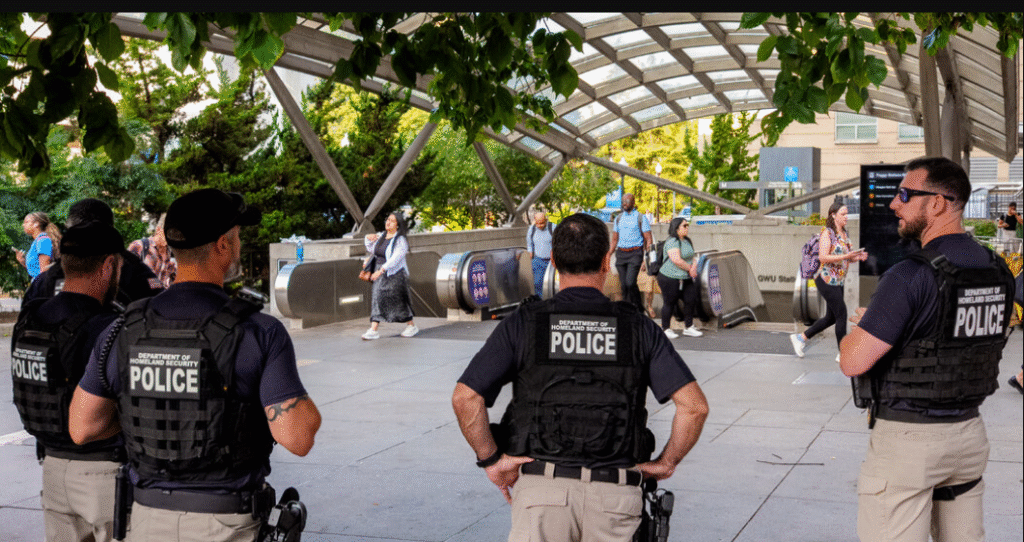Following a series of violent incidents in Washington, D.C President Donald Trump has directed an increased presence of federal law enforcement officers across the city. This effort, part of the “Making D.C. Safe and Beautiful Task Force,” aims to protect residents, tourists, and public spaces during a week of heightened enforcement, while sending a broader message about safety in the nation’s capital.
Trump’s Decision: Stepping In for Public Safety, or Another Political Move?
The order came after a notable attack on a former Department of Government Efficiency employee widely referred to by the nickname Big Balls. The assault, which reportedly left him bloodied during an attempted carjacking, raised alarm and was used by Trump to criticize the city’s crime management. In a statement, the White House emphasized that this move would ensure “no safe harbor for violent criminals in D.C.

The plan rolled out with identifiable federal agents from multiple agencies, including the U.S. Park Police, Capitol Police, FBI, DEA, ATF, and Homeland Security Investigations. Offices such as Union Station, the National Mall, and Lafayette Park were flagged as priority zones.
Trump also floated the possibility of deploying the National Guard and even threatened to federalize D.C. a move that would challenge the District’s limited self-governance.
D.C.’s Rising Crime Reality vs. Official Reports of Decline
While Trump’s move paints a picture of uncontrollable violence, official crime data paints a different story. Figures show a 35% drop in violent crime in 2024, including significant reductions in homicide, robbery, and carjacking. So far in 2025, crime continues to trend downward, with a 26% decline from last year.

That said, police acknowledge troubling developments, such as 20 homicides in May alone, nearly matching the previous year’s pace. So although crime overall is down, spikes in specific types especially youth-related violence have renewed concerns.
Federal Pushback on D.C. Autonomy Raises Political Debate
President Trump’s comments about federalizing the District sparked a broader debate about D.C.’s autonomy. Washington, D.C., operates under the Home Rule Act of 1973, which grants elected local governance but also reserves certain powers for Congress.
To fully federalize the city, Trump would need congressional approval a move likely to face fierce opposition. Critics argue such a step undermines democratic norms and local control. Supporters argue that exceptional circumstances sometimes call for federal intervention, especially when local authorities seem overwhelmed.
The temporary federal deployment involves agencies that represent strong enforcement capabilities. The instructed plan emphasizes visible presence and coordinated action with D.C.’s own Metropolitan Police Department.
Extending the Effort and Political Fallout Loom
This enforcement push is set to last a week but may be extended if violence doesn’t ease. Authorities will monitor crime rates, public response, and the effectiveness of joint operations.
Meanwhile, the political fallout is complex. Some local leaders argue D.C. is being unfairly painted as dangerous, while others say any tool is needed to protect residents. Legal scholars warn that a federal takeover would test constitutional boundaries and set a serious precedent.
President Trump’s move to boost federal law enforcement in D.C. reflects his administration’s focus on security and public order. Whether this week-long operation can meaningfully reduce targeted crime or calm community concerns remains to be seen.


 Trump Demands US Attorney General Share Epstein Data
Trump Demands US Attorney General Share Epstein Data  Trump Claims ‘Inflation Is Dead’ but June Surge Signals Otherwise
Trump Claims ‘Inflation Is Dead’ but June Surge Signals Otherwise  Has Trump Sided with Ukraine Over Russia in the War?
Has Trump Sided with Ukraine Over Russia in the War?  Trump Threatens Brazil with 50% Tariff Over Bolsonaro Trial
Trump Threatens Brazil with 50% Tariff Over Bolsonaro Trial  Trump Slaps Tariffs on Asian Nations, but India Secures Exemption
Trump Slaps Tariffs on Asian Nations, but India Secures Exemption